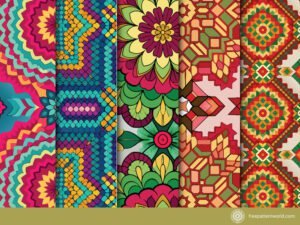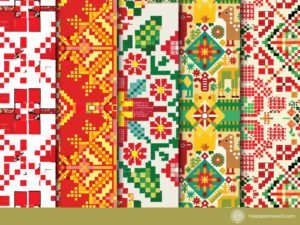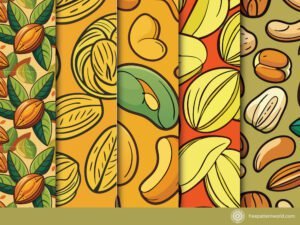
Table of Contents
Introduction
Patterns are not mere decorative elements; they are a reflection of our culture and artistic sensibilities throughout history. Modern pattern design has been shaped by an intricate interplay of artistic movements, technological advancements, and cultural shifts. In this article, we embark on a journey through time to explore the rich and fascinating history of modern pattern design.
I. The Roots of Modern Pattern Design (Late 19th Century)
The origins of modern pattern design can be traced back to the late 19th century, a period of significant social and industrial change. Two movements, in particular, laid the foundation for modern pattern design:
1. Arts and Crafts Movement (Late 19th to Early 20th Century)
The Arts and Crafts Movement, led by figures like William Morris and John Ruskin, rejected mass production in favor of handcrafted, artisanal design. Morris, known for his intricate floral and nature-inspired patterns, believed that well-designed objects could improve people’s lives.

2. Art Nouveau (Late 19th to Early 20th Century)
Art Nouveau, characterized by sinuous lines, organic forms, and intricate motifs, introduced a new design language. Artists like Alphonse Mucha and Gustav Klimt brought nature’s beauty into everyday life, infusing patterns with elegance and sensuality.
II. The Roaring Twenties (1920s)
The 1920s brought about a seismic shift in pattern design, influenced by the Art Deco movement. Art Deco patterns are characterized by geometric shapes, bold lines, and a focus on luxury and modernity. This era gave rise to the iconic geometric patterns that remain influential in design today.

III. Mid-Century Modern (1940s-1960s)
Mid-century modern design, with its emphasis on clean lines and minimalism, revolutionized pattern design. Scandinavian designers like Arne Jacobsen and Marimekko’s Maija Isola created patterns that celebrated simplicity and functionality. These patterns often featured repeating geometric shapes and bold colors.
IV. The Psychedelic ’60s and ’70s
The 1960s and ’70s witnessed a psychedelic explosion in pattern design. Inspired by counterculture movements and pop art, designers embraced vibrant colors, surreal imagery, and optical illusions. Psychedelic patterns, often featuring repetitive and kaleidoscopic motifs, were seen on everything from clothing to posters.

V. The Digital Revolution (Late 20th Century)
The late 20th century marked the advent of digital technologies, which profoundly influenced pattern design. Computer-aided design (CAD) and digital printing allowed for greater precision and experimentation in pattern creation. Artists and designers could now manipulate patterns with unprecedented ease.
VI. Contemporary Patterns (21st Century)
In the 21st century, modern pattern design continues to evolve, reflecting our globalized world and digital age:
1. Sustainable Patterns
As environmental awareness grows, sustainable patterns have gained prominence. Designers use eco-friendly materials and manufacturing processes to create patterns that are not only visually appealing but also environmentally responsible.
3. Global Fusion
Advances in digital technology have given rise to interactive patterns and augmented reality experiences. From QR codes integrated into patterns to clothing that interacts with smartphone apps, modern patterns are no longer static; they come alive in the digital realm.
3. Global Fusion
The interconnectedness of our world has led to a fusion of cultural influences in pattern design. Designers draw inspiration from diverse cultures, resulting in patterns that celebrate the richness of global traditions.
4. Customization and Personalization
Consumers now have the opportunity to customize patterns to suit their tastes. Personalization is a key trend in contemporary pattern design, allowing individuals to express their unique identities.
VII. The Impact of Modern Pattern Design
Modern pattern design has left an indelible mark on various industries and aspects of our lives:
1. Fashion and Textiles
Pattern design is an integral part of fashion, with designers and brands using patterns to create unique identities and connect with consumers. Iconic patterns, like Burberry’s plaid or Missoni’s zigzags, have become synonymous with these brands.
2. Home Decor
Patterns bring life and character to interior spaces. From wallpapers and upholstery to rugs and curtains, patterns define the aesthetic of homes and contribute to the ambiance.
3. Graphic Design and Marketing
Patterns are used in graphic design and marketing to create eye-catching visuals, convey brand messages, and engage consumers. Packaging, in particular, relies on patterns to stand out on crowded store shelves.
4. Art and Contemporary Culture
Patterns have a profound influence on art and contemporary culture. Artists, illustrators, and digital creators continue to experiment with patterns in their work, shaping the visual language of our times.
Conclusion
The history of modern pattern design is a testament to the ever-evolving nature of design and human creativity. From the Arts and Crafts Movement to the digital age, patterns have reflected our societal values, technological innovations, and artistic expressions. As we navigate the 21st century, modern pattern design continues to push boundaries, serving as a source of inspiration and a reflection of our changing world. Whether minimalist or maximalist, sustainable or interactive, modern patterns remain a vibrant and integral part of our visual culture.
Download more free pattern designs from freepatternword and freepik.
Who were some influential figures in the Arts and Crafts Movement, and how did they contribute to modern pattern design?
Influential figures in the Arts and Crafts Movement include William Morris and John Ruskin. They championed handcrafted design and emphasized the importance of well-designed objects, which significantly influenced modern pattern design.
Can you provide examples of famous Art Nouveau patterns and their characteristics?
Art Nouveau patterns often featured sinuous lines, organic forms, and intricate motifs inspired by nature. Examples include Alphonse Mucha’s posters with flowing hair and floral motifs and Gustav Klimt’s gilded and decorative patterns.
How did the Art Deco movement impact pattern design in the 1920s?
The Art Deco movement introduced bold geometric patterns characterized by clean lines and a focus on luxury and modernity. Patterns of this era often featured repeating geometric shapes, such as chevrons, zigzags, and sunbursts.
Can you explain the significance of Scandinavian designers in mid-century modern pattern design?
Scandinavian designers like Arne Jacobsen and Maija Isola played a pivotal role in mid-century modern pattern design. They embraced simplicity, functionality, and minimalism, often using repeating geometric shapes and bold colors in their patterns.
How has sustainability influenced modern pattern design in the 21st century?
Sustainability has led to the emergence of eco-friendly patterns. Designers now use sustainable materials and manufacturing processes to create patterns that are visually appealing while being environmentally responsible.
How can individuals incorporate modern patterns into their everyday lives, whether in fashion or home decor?
Individuals can incorporate modern patterns by choosing clothing, accessories, or home decor items that feature contemporary patterns. They can also explore customization options to create unique, personalized patterns that reflect their style and preferences.
These FAQs provide additional insights into the history and influence of modern pattern design, helping to clarify key aspects of this rich and evolving field.



